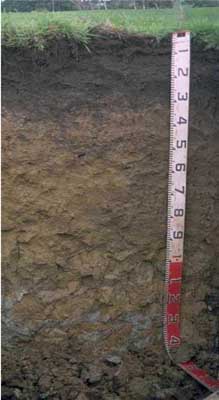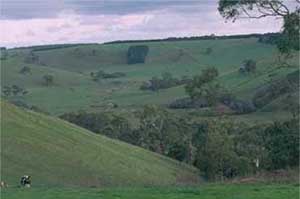SW42
|
| SW42 |  Melacic-Mottled (& Vertic), Eutrophic, Brown Chromosol (thick clay loamy surface) | |
| Cobden | |||
| Upper slope of gently undulating rises and low hills | |||
| Neogene - Moorabool Viaduct Formation. | |||
| Upper slope | |||
Horizon | Depth (cm) | Description | ||
A1 | 0–30 | Very dark greyish brown (10YR3/2); clay loam (very fine sandy); moderate coarse blocky, parting to moderate medium blocky and moderate fine polyhedral structure; weak consistence (moist); pH 5.3; boundary to: | ||
A2 | 30–35 | Brown (10YR5/3); conspicuously bleached; clay loam; discontinuous and clear boundary to: | ||
B21 | 35–60 | Yellowish brown (10YR5/4) with many (30%) brownish yellow (10YR6/6) mottles; medium clay; strong medium blocky, parting to strong fine blocky and lenticular structure; some slickensides present; weak consistence (moist); pH 6.5; boundary to: | ||
B22 | 60–80 | Light olive brown (2.5Y5/4) with many brownish yellow (10YR6/6) mottles; medium clay; lenticular structure; weak consistence (moist); pH 6.8; boundary to: | ||
B23 | 80–110 | Light olive brown (2.5Y5/4) with many brownish yellow (10YR6/6) mottles; medium clay; moderate very coarse prismatic, parting to moderate coarse blocky structure; large slickensides present; very firm consistence (moist); pH 6.9; boundary to: | ||
B3 | 110+ | Grey (N/5) with brownish yellow (10YR6/8) and some red mottles; medium clay; large slickensides present; very firm consistence (moist); pH 6.8. | ||
| Management considerations | ||||
| The following comments are made on the basis of examination of a single profile and are therefore indicative only. Fertiliser and lime requirements would need to be verified and quantified through analysis of bulk samples of standard depth taken from across a whole paddock. The surface soil is strongly acid. This indicates that aluminium and manganese toxicity may occur. Lime can be used to increase soil pH. Other factors need to be considered before lime is recommended (e.g. pasture species grown, method of application, local trial responses, soil surface structure and likely cost/benefit). Manganese toxicity is more likely to occur in poorer drained situations (as waterlogging may bring manganese into solution). If lime is required, and pH increased, then the availability of major nutrients (e.g. phosphorus and some trace elements such as molybdenum) may improve. The surface soil is quite deep, has reasonable organic matter levels, is well structured (parting to fine polyhedral shaped peds) and is quite friable when moist. These attributes indicate that the surface soil will be very conducive to plant growth. The strong texture contrast between the surface soil and the subsoil is a very important soil feature. This can have a major effect by reducing and/or redirecting the internal drainage and restricting root growth beyond the upper horizons. The subsoil is vertic, which indicates that significant shrinking and swelling occurs during wetting and drying cycles. This may disturb the roots of some plant species and has engineering implications (e.g. disturbance to fencelines and building foundations). The deeper subsoil (from 60 cm depth) is sodic and disperses slightly in water. This indicates that root and water movement will be more restricted in the deeper subsoil. Mottled subsoils are common and are an indication of periodic waterlogging, particularly if the mottles are pale (low oxygen conditions). The subsoil has a moderate linear shrinkage and high plasticity and will crack on drying. They appear not to be ideal soils for mole drainage as moles may have a limited lifespan. Moles should be best formed when soils are wetter than 300kPa. | ||||
Analytical data
Site SW42 | Sample depth | pH | EC | NaCl | Ex Ca | Ex Mg | Ex K | Ex Na | Ex Al | Ex acidity | FC (-10kPa) | PWP (-150kPa) | KS | FS | Z | C | |
Horizon | cm | H2O | CaCl2 | dS/m | % | cmolc/kg | cmolc/kg | cmolc/kg | cmolc/kg | mg/kg | cmolc/kg | % | % | % | % | % | % |
A1 | 0–30 | 5.3 | 4.7 | 0.17 | N/R | 7.4 | 1.5 | 0.4 | 0.05 | N/R | N/R | 37.6 | 17.2 | 8 | 34 | 16 | 22 |
A2 | 30–35 | N/R | N/R | N/R | N/R | N/R | N/R | N/R | N/R | N/R | N/R | N/R | N/R | N/R | N/R | N/R | N/R |
B21 | 35–60 | 6.5 | 5.7 | 0.13 | N/R | 9.5 | 6.2 | 0.2 | 0.7 | N/R | N/R | 51.8 | 29.2 | 6 | 16 | 7 | 64 |
B22 | 60–80 | 6.8 | 6.0 | 0.14 | N/R | 8.8 | 7 | 0.2 | 1.4 | N/R | N/R | 53.9 | 30 | 4 | 14 | 6 | 68 |
B23 | 80–110 | 6.9 | 6.2 | 0.21 | N/R | 10 | 7.8 | 0.1 | 2.4 | N/R | N/R | 57.8 | 30.5 | 3 | 14 | 7 | 69 |
B3 | 110+ | 6.8 | 6.0 | 0.31 | 0.04 | 9 | 7.1 | 0.1 | 2.7 | N/R | N/R | 48.4 | 26.6 | 17 | 16 | 8 | 54 |



